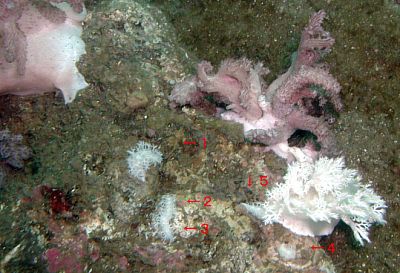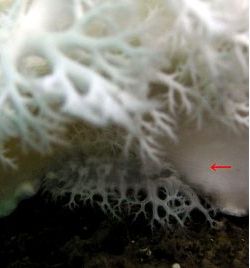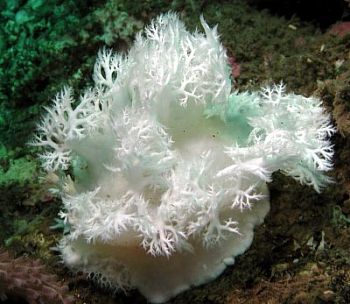Tritoniopsis elegans and camouflage
October 18, 2001
From: Nishina Masayoshi

Dear Dr.Rudman,
I have observed the ecology of the various sea slugs in the sea before but I was really surprised at this observation. I could find what I thought at first was one sea slug [Tritoniopsis elegans when I turned over a stone (LOWER RIGHT). But, my wife noticed that gills apparently grew from that animal's foot as well (LOWER LEFT).
So I tried to remove the big sea slug from the stone because it seemed very strange for it to have gills on its foot. Then, five little sea slugs moved out from under that animal. Five little sea slugs were hiding under the foot or beside the foot of the big sea slug. It was an unbelievable sight (UPPER RIGHT PHOTO).
I sometimes see groups of the same sea slugs together but they are usually of the same size. Meanwhile, the big sea slug began to move to the end of the stone, and when it stopped one of the small ones followed it like a child following its parents. I realise that these animals don't provide 'childcare' and probably the large one isn't a parent of the small ones but it certainly gave that impression. Then, What does this mean? Are they only just hiding or are they clustered together for camouflage in a place where they look like the soft corals? I see that Bernard Picton has already sent a similar photo of T. elegans to Forum before. I wonder if the juveniles in his photo were hidden under the adult? or whether they were just close together?
Data:
Date:14 Oct, 2001
Location: Fukuura Port, Sagami Bay Japan
Length: Biggest one 50mm-60mm
Small sea slugs 10mm to 20mm
Best Regards,
Nishina Masayoshi
nishina@wips.co.jp


Dear Nishina,
What an interesting observation. I think the basic reason they are all together is that their food is nearby. I guess they were eating the colony which we can see broken off in your upper photo. Many sea slugs which eat massive colonies of soft corals and hard corals, cluster around the base of the colony, especially when they are juveniles, and in the case of hard corals like
I suspect that when large animals and small ones are together, the larger ones can crawl over the small ones like in your example. When they are very small their natural defence seems to be to hide, but as they grow larger and begin to look much like their food, they spend less time 'hiding' in crevices and under things, and begin to sit out in the open on their food, apparently relying on their camouflage to protect them.
Best wishes,
Bill.
Related messages
-
Tritoniopsilla elegans - egg laying
From: Sven Kahlbrock, September 19, 2008 -
A case of Caphira yoodokai eating Tritoniopsis elegans
From: Seiko Kuroe & Akira Mada, July 7, 2007 -
Tritoniopsis elegans in aquarium
From: Andrea Urban, March 13, 2007 -
Feeding Tritoniopsis elegans
From: Vik Shah, August 17, 2006 -
Can you help Identify this hitchhiker?
From: Jimmy Carmichael, January 13, 2006 -
Unidentified Nudibranch in aquarium
From: David Seibel, December 24, 2004 -
Tritoniopsis elegans from Red Sea
From: Oren Lederman, August 11, 2004 -
Tritonopsis elegans from Kenya
From: Ann Clear, July 19, 2004 -
Re: Tritoniopsis elegans in aquaria [2]
From: Albert Jeffer, March 16, 2004 -
Tritoniopsis elegans in aquaria
From: Wade Waldman, March 12, 2004 -
Tritoniopsis elegans in aquaria [2]
From: Albert Jeffers, March 12, 2004 -
Finally found in Queensland
From: Gary Cobb, November 19, 2003 -
Re: Tritoniopis elegans in aquarium
From: Chris Peacock, July 18, 2003 -
Tritoniopis elegans in aquarium
From: Chris Peacock, July 5, 2003 -
Tritoniopsis elegans in aquarium
From: Ember Barnett, May 30, 2003 -
Tritoniopsis elegans in home aquarium
From: Brian Lindsay , February 28, 2003 -
ID Sea Slug
From: Joe, February 13, 2003 -
Re: Tritoniopsis elegans in aquarium
From: Marc Daniels, January 25, 2003 -
Are these Tritoniopsis elegans eggs?
From: Onel, January 25, 2003 -
Tritoniopsis elegans in aquarium
From: Marc Daniels, January 22, 2003 -
Tritoniid in aquarium
From: Mary Middlebrook, January 18, 2003 -
Tritoniopsis elegans - causing aquarium problems
From: Sam Young, November 11, 2002 -
Unexpected Tritoniopsis elegans guests
From: Mark Armstrong, May 31, 2002 -
Tritoniopsilla alba ? from the Philippines
From: Erwin Koehler, April 24, 2002 -
White nudibranch from Dendronephthya
From: Wyatt Patry , September 26, 2001 -
Another aquarium mystery
From: Christy Falkenberg, September 16, 2001 -
Tritoniopsis elegans - eggs
From: Bernard Picton , August 19, 2001 -
Tritoniopsis elegans feeding
From: Leslie Chan, August 18, 2001 -
Tritoniopsis elegans from Hong Kong
From: Bernard Picton , August 18, 2001 -
Tritoniopsis elegans - hitchhiker
From: Tom O'Toole, July 31, 2001 -
Tritoniopsis elegans from Hong Kong
From: Leslie Chan, July 8, 2001 -
Tritoniopsis elegans in aquarium
From: Donna Pinnock, May 11, 2001 -
Tritoniopsis elegans in aquarium
From: Tracey Bollier, February 9, 2001 -
Tritoniopsis elegans from South Africa
From: Valda Fraser, January 27, 2001 -
Unknown Nudibranch
From: Marc Elig, December 12, 2000 -
Tritoniopsis - another hitchhiker
From: Jim Roth, September 23, 2000 -
Tritoniopsis elegans in aquarium
From: Cindy Nichols, January 4, 2000 -
Tritoniopsis from Thailand
From: Erwin Koehler, July 9, 1999 -
Sponge-feeding tritoniid?
From: David & Leanne Atkinson, April 14, 1999 -
Nudibranch in reef tank
From: Eirik Mack Eilertsen, January 4, 1999 -
Re: Nudibranch in reef tank
From: Eirik Mack Eilertsen , January 4, 1999
